- Solid Cedar top
- Solid Indian rosewood back and sides.
- Mahogany neck with 2 ebony strips
- Ebony fretboard
- 19 frets
- Rosewood bridge
- Gold engraved Fostero tuners. Fustero tuners are individually made by hand in Spain from the best materials…for decades they have adorned high end instruments built by Fleta, Ramirez, Kohno, Contreras, Bernabe and others.
- 660mm scale length
- 2" nut width
- String spacing at the nut: 1 11/16 inch
- Condition: One, repaired cracks:4 1/2 inches long, about 2 inches to the north (bass side) of the fretboard extension over the body.
-
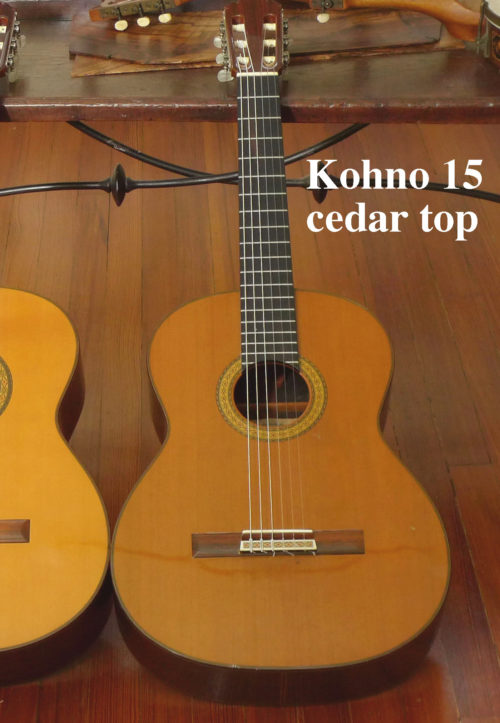 Kohno Classical Guitar. 1976 This instrument is being sold for a customer in Houston with a large collection of guitars. This guitar was originally purchased from VintageAmericanGuitar some five years ago– and its tone has aged and improved. The original Kohno design was specifically different from the high-end Spanish "concert" guitars of the day which had high action and beefy necks (and often long 664 or longer scale lengths). The Kohno necks were moderately thin in profile and shaped for very fluid playability. They’re a joy to play, physically. The 660 scale length– not overly long to begin with– actually “feels” shorter because of the neck design. (And the string spacing at the 2-inch nut: 1 11/16 inches, is also a great feature that adds to the great left hand feel.) We’ve seen/played many Kohnos– this one is unique in the combination of woods, and tone. Cedar top (not spruce), and Indian Rosewood back and sides. The combination, and this guitar’s age and unique voicing produce a dark, bass-rich tone and super clear and strong mids rarely found in a Kohno. It’s louder, darker and deeper than other Kohnos, yet is has great string separation– and the high E string is bell-like and loud.
Kohno Classical Guitar. 1976 This instrument is being sold for a customer in Houston with a large collection of guitars. This guitar was originally purchased from VintageAmericanGuitar some five years ago– and its tone has aged and improved. The original Kohno design was specifically different from the high-end Spanish "concert" guitars of the day which had high action and beefy necks (and often long 664 or longer scale lengths). The Kohno necks were moderately thin in profile and shaped for very fluid playability. They’re a joy to play, physically. The 660 scale length– not overly long to begin with– actually “feels” shorter because of the neck design. (And the string spacing at the 2-inch nut: 1 11/16 inches, is also a great feature that adds to the great left hand feel.) We’ve seen/played many Kohnos– this one is unique in the combination of woods, and tone. Cedar top (not spruce), and Indian Rosewood back and sides. The combination, and this guitar’s age and unique voicing produce a dark, bass-rich tone and super clear and strong mids rarely found in a Kohno. It’s louder, darker and deeper than other Kohnos, yet is has great string separation– and the high E string is bell-like and loud. -
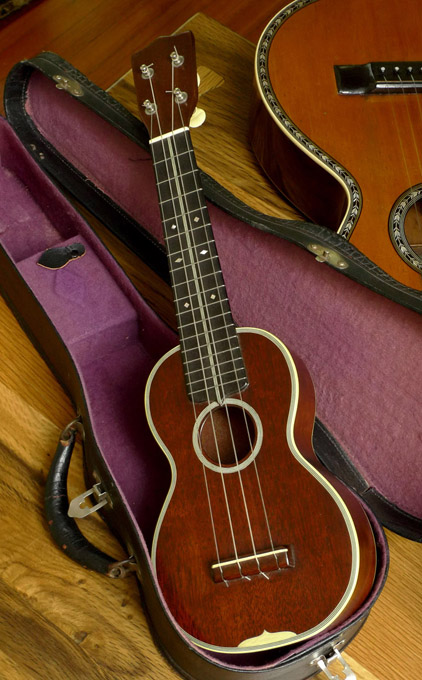 In the 1920’s and early 30's, the Hawaiian craze was in full bloom, and ukulele production was crucial to Martin’s success in this period. This is a wonderful, extremely well-preserved example of one of the most ornate of the Martin ukuleles, still in its original Geib case. Although Martin ukes built after 1916 carried no serial number, it’s possible to generally date them by stylistic elements. This Martin Style 3 is from the best era, the golden era, from about 1925 to 1930. Martin style 3 was first made in 1918. Martin Style 3, soprano (standard) specs:
In the 1920’s and early 30's, the Hawaiian craze was in full bloom, and ukulele production was crucial to Martin’s success in this period. This is a wonderful, extremely well-preserved example of one of the most ornate of the Martin ukuleles, still in its original Geib case. Although Martin ukes built after 1916 carried no serial number, it’s possible to generally date them by stylistic elements. This Martin Style 3 is from the best era, the golden era, from about 1925 to 1930. Martin style 3 was first made in 1918. Martin Style 3, soprano (standard) specs:- Mahogany body
- 7 layer top binding
- 3 layer back binding
- Ebony fretboard
- 5 layer soundhole ring
- Celluloid ornament on top, behind bridge (known as the "parend", or “shield”)
- Bar frets
- Small pearl paired-diamond inlays at fret 5, 7, and 9
- Three lines inlaid down center of fingerboard
- Nickel plated pegs (introduced in 1923)
- CF Martin & Co, stamped on back of peghead, and inside-back (Martin logo was not put on front of peghead until 1932)
-
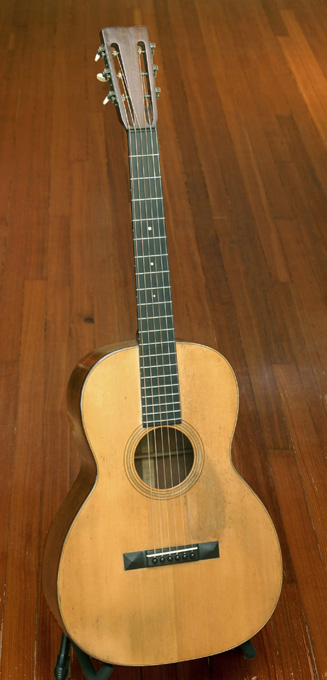 A steel-string braced 00-18, with finely scalloped braces, and light as a feather. No wonder the tone is exquisite. This 12-fret gem, from the best era for Martin12-frets, resonates in your hands (say what you want about the 30’s, but the more lightly-built Martins of the 20’s become an extension of your body). The set up is low (4 to 5 64ths), so it plays like a dream. Original finish throughout. Mahogany back and sides. Adirondack spruce top. Ebony fingerboard. Original tuners/gear wheel below worm gear, ivoroid buttons. The instrument was acquired from one of North America’s top Martin restoration shops, Folkway Music, who reported: “This 00-18 went back to Martin in the late 80's for a neck reset, refret, re-bridge, and a new bridge plate. The back has one repaired crack, and there are two well repaired side cracks. Martin's repairs are well done, the new bar frets are nice and tall, and the bridge plate (maple) is only slightly oversized. The somewhat oversized pyramid bridge didn't look great when the guitar came in, so we re-profiled it here in shop and fitted a new bone saddle and vintage-correct bridge-pins.” This instrument will not disappoint. It has been correctly and meticulously restored by Martin, and by one of the world’s top Martin experts. It’s ready for decades of enjoyment.
A steel-string braced 00-18, with finely scalloped braces, and light as a feather. No wonder the tone is exquisite. This 12-fret gem, from the best era for Martin12-frets, resonates in your hands (say what you want about the 30’s, but the more lightly-built Martins of the 20’s become an extension of your body). The set up is low (4 to 5 64ths), so it plays like a dream. Original finish throughout. Mahogany back and sides. Adirondack spruce top. Ebony fingerboard. Original tuners/gear wheel below worm gear, ivoroid buttons. The instrument was acquired from one of North America’s top Martin restoration shops, Folkway Music, who reported: “This 00-18 went back to Martin in the late 80's for a neck reset, refret, re-bridge, and a new bridge plate. The back has one repaired crack, and there are two well repaired side cracks. Martin's repairs are well done, the new bar frets are nice and tall, and the bridge plate (maple) is only slightly oversized. The somewhat oversized pyramid bridge didn't look great when the guitar came in, so we re-profiled it here in shop and fitted a new bone saddle and vintage-correct bridge-pins.” This instrument will not disappoint. It has been correctly and meticulously restored by Martin, and by one of the world’s top Martin experts. It’s ready for decades of enjoyment. -
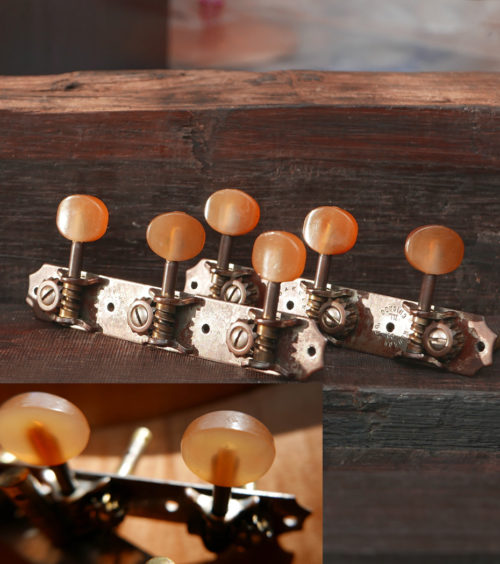 Pre-war Kluson tuners from the 1930's. Amber buttons. These are rare tuners that came on some of the nice Gibsons of the era, such as a few Gibson J35's. Good working condition. Price: $295. – on Hold
Pre-war Kluson tuners from the 1930's. Amber buttons. These are rare tuners that came on some of the nice Gibsons of the era, such as a few Gibson J35's. Good working condition. Price: $295. – on Hold -
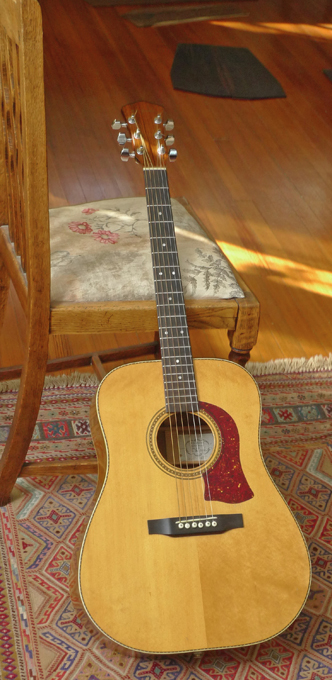 Stuart Mossman was one the country’s top luthiers in the 1970s and 80s– working in the tradition of the great American Dreadnought. According to an article in Vintage Guitar magazine: Stuart Mossman “…. began making guitars in 1965 and through his early efforts concentrated on experimenting with bracing of the tops. He spent four years building 40 or 50 prototypes in his garage at home. By the end of the decade, sensing a niche in the market for high quality handmade acoustics, he had incorporated S. L. Mossman Guitars in Winfield, Kansas and moved into facilities at Strother's Field outside of town. Mossman had noticed what was happening with major acoustic guitar manufacturers at the time. The folk music boom had pushed demand for acoustic instruments to an all-time high and while Gibson, Martin and Guild were increasing production, imports from the Pacific rim countries were beginning to exploit the lower end of the market. Mossman was concerned with what he saw as an erosion in materials, design, and craftsmanship in the construction of the traditional flattop acoustic guitar, particularly among the larger manufacturers as they rushed to meet the strong demand. Using only top-quality woods, a proprietary bracing structure, and old-world building techniques, Mossman guitars entered series production in 1970. ‘We were the first of the small manufacturers to make it as a larger company', Stuart Mossman recalls…” The original 70’s Mossman dreadnoughts are very well built, with attention to detail, and craftsmanship unsurpassed in this period. One of the hallmarks of the Mossman guitar is that each instruments has a paper label inside, with the serial number (that included the year date) and model. And the label was always signed or initialed by the craftsmen building that guitar (this one includes Stu Mossman’s initials: SLM). The Flint Hills model featured East Indian Rosewood back and sides, spruce top, ebony fretboard and bridge, and a unique inlay around the soundhole. This example is all original, and is in fine condition, with no cracks. Original West German Schaler tuners. It has an under-saddle pickup installed, and an input jack in the end pin. Tone is fine, and loud, reminiscent of a 60’s Martin– but with a little more punch in the mids and trebles– a perfect bluegrass instrument.
Stuart Mossman was one the country’s top luthiers in the 1970s and 80s– working in the tradition of the great American Dreadnought. According to an article in Vintage Guitar magazine: Stuart Mossman “…. began making guitars in 1965 and through his early efforts concentrated on experimenting with bracing of the tops. He spent four years building 40 or 50 prototypes in his garage at home. By the end of the decade, sensing a niche in the market for high quality handmade acoustics, he had incorporated S. L. Mossman Guitars in Winfield, Kansas and moved into facilities at Strother's Field outside of town. Mossman had noticed what was happening with major acoustic guitar manufacturers at the time. The folk music boom had pushed demand for acoustic instruments to an all-time high and while Gibson, Martin and Guild were increasing production, imports from the Pacific rim countries were beginning to exploit the lower end of the market. Mossman was concerned with what he saw as an erosion in materials, design, and craftsmanship in the construction of the traditional flattop acoustic guitar, particularly among the larger manufacturers as they rushed to meet the strong demand. Using only top-quality woods, a proprietary bracing structure, and old-world building techniques, Mossman guitars entered series production in 1970. ‘We were the first of the small manufacturers to make it as a larger company', Stuart Mossman recalls…” The original 70’s Mossman dreadnoughts are very well built, with attention to detail, and craftsmanship unsurpassed in this period. One of the hallmarks of the Mossman guitar is that each instruments has a paper label inside, with the serial number (that included the year date) and model. And the label was always signed or initialed by the craftsmen building that guitar (this one includes Stu Mossman’s initials: SLM). The Flint Hills model featured East Indian Rosewood back and sides, spruce top, ebony fretboard and bridge, and a unique inlay around the soundhole. This example is all original, and is in fine condition, with no cracks. Original West German Schaler tuners. It has an under-saddle pickup installed, and an input jack in the end pin. Tone is fine, and loud, reminiscent of a 60’s Martin– but with a little more punch in the mids and trebles– a perfect bluegrass instrument. -
Out of stock
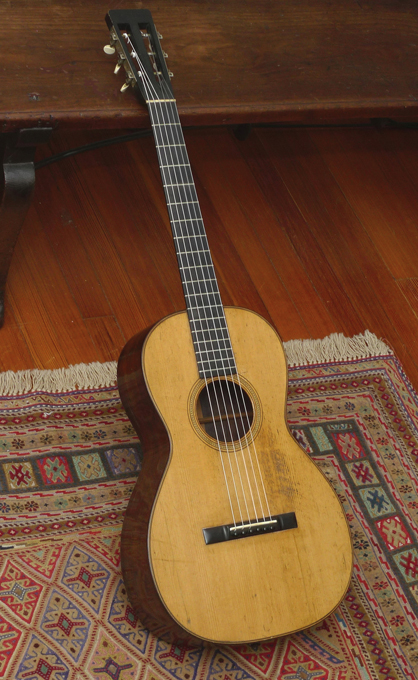 1855-1860 Martin “transitional”1-21. A very rare and exquisite large size Martin from the pre-1867 era. “Large size” Martin from the 1850’s, because the Size 1, and 0, were the only “large” size Martins in those years. And there is currently not a single other size 1 or 0 size pre-1867 Martin guitar on the market. This is considered by the top U.S. experts who vetted this instrument as an early, rare "transitional" 1-21, based on the fact that it does not have all the later, standardized, 1860’s and on “21” attributes– specifically, backstrip and endwedge on this instrument are not typical of “price-list” era 21’s (after the publishing of the first Martin price lists, establishing features of the different models, in the 1860’s) This 1-21 has:
1855-1860 Martin “transitional”1-21. A very rare and exquisite large size Martin from the pre-1867 era. “Large size” Martin from the 1850’s, because the Size 1, and 0, were the only “large” size Martins in those years. And there is currently not a single other size 1 or 0 size pre-1867 Martin guitar on the market. This is considered by the top U.S. experts who vetted this instrument as an early, rare "transitional" 1-21, based on the fact that it does not have all the later, standardized, 1860’s and on “21” attributes– specifically, backstrip and endwedge on this instrument are not typical of “price-list” era 21’s (after the publishing of the first Martin price lists, establishing features of the different models, in the 1860’s) This 1-21 has:- Diamond marquetry backstrip (not found on later, 1860’s 1-21s)
- Marquetry endwedge (not found on later, 1860’s 1-21s) (Wood end wedge and herringbone backstrip were the standard features of the 1860’s and after 1-21’s)
- X-braced. All braces are 100% original. No internal repairs to braces.
- Slot head
- Ebonized neck (maple neck, ebonized, i.e. painted black). This is another transitional feature: black neck was replaced by cedar on Style 21 by the time the Martin price list was first printed.
- Single "tone bar" brace behind the bridge plate
- Ice cream cone-shaped heel (1860’s 1-21’s had cedar neck, with Spanish style heel not ice cream cone heel)
- Three "CF Martin New-York" stamps: one inside center strip; the second on neck block (this stamp is upside down, as it should be); the third on back of guitar (near heel), the third stamp transversing the backstrip on the back of the guitar near the heel.
- Solid Brazilian Rosewood back and sides
- All original finish, everywhere; no touch-ups, overspray, etc, of any kind ever done
- Brazilian rosewood back shows beautiful sawmarks
- Bridge, more than a century old, is probably a replacement bridge… but on the original bridge footprint
- Original ivory nut
- Original bridge plate (mahogany)
- No back cracks, or side cracks; one top crack, repaired
- Tuners are modern replacements, vintage style, in original slot holes
- Original frets
-
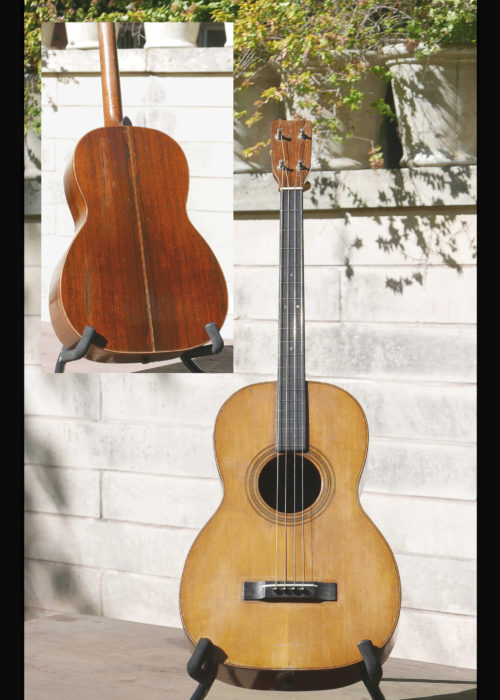 The 5-21 Martins, with their Brazilian Rosewood back and sides and Adirondack spruce tops, are known for putting out an astounding amount of sound. This tenor guitar, style 5-21T, does that in spades. Measuring 11-3/8" across, with its X braced top and light build, the instrument has an amazing amount of tone. Though Martin offered size 5 models ranging from style 15 through the elaborately ornamented style 45, the only ones made in any significant quantity prior to World War II were the style 17, 18, and 21 in six-string guitars and styles 17, 18, and 21 tenors, as well as some style 15 post-war size 5 tenors. Features of this instrument:
The 5-21 Martins, with their Brazilian Rosewood back and sides and Adirondack spruce tops, are known for putting out an astounding amount of sound. This tenor guitar, style 5-21T, does that in spades. Measuring 11-3/8" across, with its X braced top and light build, the instrument has an amazing amount of tone. Though Martin offered size 5 models ranging from style 15 through the elaborately ornamented style 45, the only ones made in any significant quantity prior to World War II were the style 17, 18, and 21 in six-string guitars and styles 17, 18, and 21 tenors, as well as some style 15 post-war size 5 tenors. Features of this instrument:- Recent neck set, and leveling of original bar frets, action is very good
- Original Grover tuning machines, working well
- Nut width of 1 1/4"
- Scale length: 22.5"
- 1 3/8" string spacing at the saddle
- Had an added tailpiece at once point (3 tiny screw holes near end pin
- No top cracks
- One repaired 11" crack on the bottom lower bout side
- One 6" repaired crack on the upper bout back under the herring bone center inlay,
- One 4” repaired crack on the lower bout back towards the bottom
- A small hole at the center of the rear headstock– probably at some point for a nail to hang the instrument on a wall
- Neck has a comfortable V shape, leaning toward a U profile
-
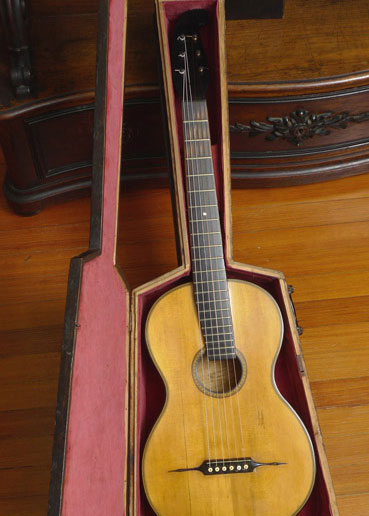 Read the full description below. If you're interested in this guitar, please call 512.922.8596 or contact us here.
Read the full description below. If you're interested in this guitar, please call 512.922.8596 or contact us here. -
 Very few modern luthiers have captured that Larson Brothers sustain and what I call “shimmer” with a new build. This guitar, built by the master luthier Hans Brentrup in late 2009, has it in spades. We’ve never played anything but a 30’s Larson Bros’ that has the sustain this guitar has. Hans’ unique tone bars do what only the Larson tone bar system did– get the body of the guitar to sustain and impart that wonderful shimmer to the trebles especially.
Very few modern luthiers have captured that Larson Brothers sustain and what I call “shimmer” with a new build. This guitar, built by the master luthier Hans Brentrup in late 2009, has it in spades. We’ve never played anything but a 30’s Larson Bros’ that has the sustain this guitar has. Hans’ unique tone bars do what only the Larson tone bar system did– get the body of the guitar to sustain and impart that wonderful shimmer to the trebles especially.- Brazilian Rosewood back and sides
- Engelmann spruce top
- 000 size
- 25.34 scale length
- Easily accommodates Medium or Heavy strings
- Hybrid ladder laminated bracing with Carbon fiber “Tone tubes”
- Mahogany neck
- Slotted headstock
- Golden Age tuners
- Ebony fingerboard with MOP dots
- Pyramid bridge
- Tortoise body binding
- Lacquer finish
-
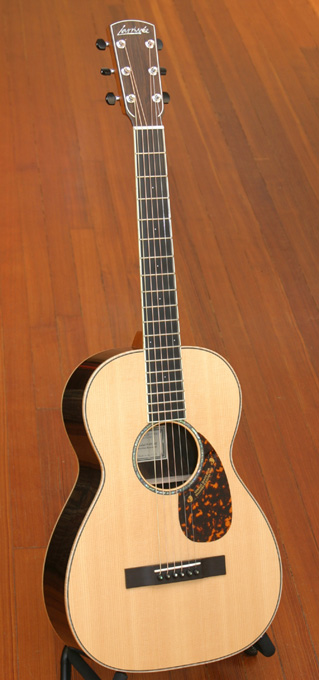 Mint condition. Period. Exceptional Larrivee 12-fret parlor guitar with a straight grained Sitka Spruce top and beautifully figured Brazilian Rosewood back & sides. Part of a very limited run of guitars built of high grade old stock Brazilian rosewood. Abalone rosette and tortoise shell pickguard. Ebony bridge w/ compensated saddle. Mahogany neck w/ microdot inlays, ivoroid bound ebony fingerboard, 1-3/4" nut, 24-1/4" scale, 13-1/4" lower bout, Larrivee logo peghead inlay, chrome tuners w/ebony buttons.
Mint condition. Period. Exceptional Larrivee 12-fret parlor guitar with a straight grained Sitka Spruce top and beautifully figured Brazilian Rosewood back & sides. Part of a very limited run of guitars built of high grade old stock Brazilian rosewood. Abalone rosette and tortoise shell pickguard. Ebony bridge w/ compensated saddle. Mahogany neck w/ microdot inlays, ivoroid bound ebony fingerboard, 1-3/4" nut, 24-1/4" scale, 13-1/4" lower bout, Larrivee logo peghead inlay, chrome tuners w/ebony buttons. -
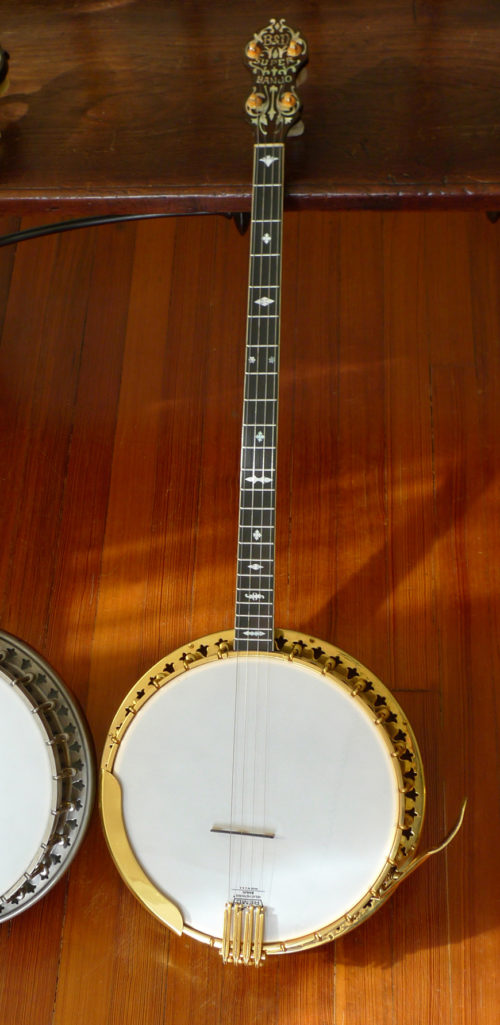 This rare 1926 example of Bacon & Day’s Super, Plectrum banjo is in wonderful condition– collectors quality, but it plays wonderfully. And this is the rare “Super” model A, gold plated. (All original, and with matching serial number on rim and dowel stick.) Original soft pedal stamped "Pat. Pend. B.&D. Soft Pedal." The original gold plating is in great condition, showing extremely little tarnishing, and no thin spots. In fact the banjo shows very little playwear at all. Original plectrum neck, original armrest– in fact all parts are original. Produced in the golden age of Bacon & Day (B&D) production, this banjo was made in Groton, CT. Although the earliest Bacon banjos were produced by various makers for Bacon from 1906-1920, the company’s best era began in 1922 when David Day left the Vega company to partner with Fred Bacon who had begun crafting his instruments in-house in 1920. The B&D banjos produced in this era are of considerably higher quality and are the sought after models by both players and collectors. The photos tell the story. 26 inch scale length. 22 fret plectrum 11″ rim In a recent hard shell case. ... no longer available ...
This rare 1926 example of Bacon & Day’s Super, Plectrum banjo is in wonderful condition– collectors quality, but it plays wonderfully. And this is the rare “Super” model A, gold plated. (All original, and with matching serial number on rim and dowel stick.) Original soft pedal stamped "Pat. Pend. B.&D. Soft Pedal." The original gold plating is in great condition, showing extremely little tarnishing, and no thin spots. In fact the banjo shows very little playwear at all. Original plectrum neck, original armrest– in fact all parts are original. Produced in the golden age of Bacon & Day (B&D) production, this banjo was made in Groton, CT. Although the earliest Bacon banjos were produced by various makers for Bacon from 1906-1920, the company’s best era began in 1922 when David Day left the Vega company to partner with Fred Bacon who had begun crafting his instruments in-house in 1920. The B&D banjos produced in this era are of considerably higher quality and are the sought after models by both players and collectors. The photos tell the story. 26 inch scale length. 22 fret plectrum 11″ rim In a recent hard shell case. ... no longer available ... -
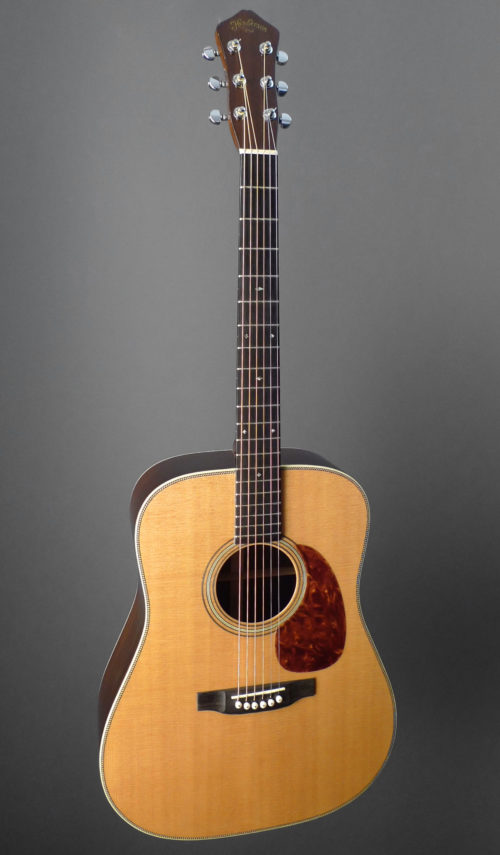 This week, to honor the just-announced winners of the 2018 Wayne Henderson Guitar Festival, we call out not an individual guitar, but rather one of the greatest American luthiers working today– and especially that luthier’s (and great player’s) work for youth in his area. We’re speaking of course of Wayne Henderson, and his legendary Festival. Every June Wayne Henderson hosts on of the most culturally important music festivals in the U.S., at the amphitheater in Grayson Highlands State Park near Henderson’s home and shop in Rugby, Virginia. The guitar- and generally music-loving attendees hear great music while supporting scholarships for young musicians in the area. And at the heart of the festival is the guitar competition. Click here to see the just-announced winners. And here’s a look at Fretboard Journal’s visit to the festival– and to Wayne Henderson’s luthier’s shop– a few years back. Click here for the article. .
This week, to honor the just-announced winners of the 2018 Wayne Henderson Guitar Festival, we call out not an individual guitar, but rather one of the greatest American luthiers working today– and especially that luthier’s (and great player’s) work for youth in his area. We’re speaking of course of Wayne Henderson, and his legendary Festival. Every June Wayne Henderson hosts on of the most culturally important music festivals in the U.S., at the amphitheater in Grayson Highlands State Park near Henderson’s home and shop in Rugby, Virginia. The guitar- and generally music-loving attendees hear great music while supporting scholarships for young musicians in the area. And at the heart of the festival is the guitar competition. Click here to see the just-announced winners. And here’s a look at Fretboard Journal’s visit to the festival– and to Wayne Henderson’s luthier’s shop– a few years back. Click here for the article. .